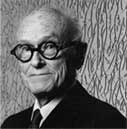
Philip Johnson’s arrival into the field of architecture began with his appointment in 1946 as Director of the Department of Architecture and Design at the Museum of Modern Art in New York City. This program was the first of its kind in the nation dedicated to the study of architecture as art. While there, Johnson collaborated with historian Henry-Russell Hitchcock to curate the groundbreaking exhibition The International Style. This revolutionary exhibit introduced American architects as well as the general public to European modernism and especially the work of Mies vander Rohe, Walter Gropius, and Le Corbusier.
At the age of 34, Johnson began studying architecture at Harvard under Marcel Breuer. Work from his early career includes one of Johnson’s most famous buildings, the “Glass House” (1949), which was heavily influenced by his mentor Mies van der Rohe and his “Farnsworth House” (1946). In the coming decades, Johnson would become one of America’s most celebrated and prolific architects. The 1960s saw a number of important commissions including the Roofless Church (1960), Kline Biology Tower (1962-66), and the New York State Theater at Lincoln Center in New York (1963).
Following the successful design of the New York State Theater at Lincoln Center, Governor Nelson Rockefeller commissioned Johnson to design the New York State Pavilion for the upcoming 1964-65 New York World’s Fair. This commission came at a time when Johnson began to break away from Miesian traditions and instead experimented with incorporating classical elements and ornamentation into his designs. Working with structural engineer Lev Zetlin, Johnson and his partner Richard Foster designed a pavilion complex that showcased architectural as well as technological innovation in a playful manner befitting the Fair.
Later, with partner John Burgee (1967-1991), Johnson reinvented himself again rejecting the modernist themes he once espoused. Ever the architectural gadfly, he adopted the freer historical references of “post-modernism” in the 1980s in several large scale structures such as the AT&T Building in New York City (1984) while nearly simultaneously organizing the influential 1988 exhibition Deconstructivist Architecture at the Museum of Modern Art.
In 1979, Philip Johnson was honored with the first Pritzker Architecture Prize in recognition of “50 years of imagination and vitality embodied in a myriad of museums, theaters, libraries, houses, gardens and corporate structures.” He also received the highest honor of the architectural profession when he was awarded the Gold Medal of the American Institute of Architects. Philip Johnson died in January 2005 at the age of 98.